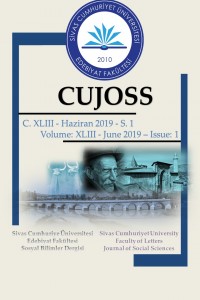HEAD CIRCUMFERENCE PERCENTILES FOR 0-3-YEAR-OLD INFANTS IN TURKEY: THE RESULTS OF A NATIONWIDE GROWTH STUDY
Abstract
Population-based growth studies are important to
demonstrate social, cultural, and medical milieu of the societies. The fact that
there is no nationwide head circumference growth references of Turkish children
is a significant deficiency. In this study, we aimed to create head growth
references for 0-3-year-old children living in good conditions in Turkey.
Within this scope, a total of 2061 infants and children with 1029 being boys
and 1032 girls were examined in seven metropolitan city (Istanbul, Ankara,
İzmir, Adana, Samsun, Diyarbakır, and Erzurum) in Turkey. LMS method was used
to create percentile curves. According to the data obtained, it can be said
that children of our country who grow in optimal and/or sub-optimal conditions
have somewhat larger head circumference compared to their peers from the USA,
but the difference is relatively low. Great similarity between the results of
this study, which was conducted as multicenter, and previous reference studies
performed in Istanbul is remarkable.
References
- Anzo, M., Takahashi, T., Sato, S., Matsuo, N. (2009). The cross-sectional head circumference growth curves for Japanese from birth to 18 years of age: the 1990 and 1992-1994 national survey data. Annals of Human Biology, 29:373-388. Cogill, B. (2003). Anthropometric Indicators Measurement Guide, Food and Nutrition Technical Assistance Project, Academy for Educational Development, Washington DC. Cole, T.J., Green, P.J. (1992). Smoothing Reference Centile Curves - the LMS Method and Penalized Likelihood, Statistics in Medicine, 11, s. 1305–19. de Onis, M.,Victora, C.G., Garza, C., Frongillo, E.A. & Cole, T. J. (2001). “A new international growth reference for young children”, in: Perspectives in Human Growth, Development and Maturation (Ed: Dasgupta P., Hauspie R.). Dordrecht, The Netherlands: Kluwer Academic Publishers, s. 45-53. Duyar, İ. (1992). 12-17 Yaş Grubu Türk Çocuklarının Büyüme Standartları, (Yayımlanmamış Doktora Tezi). Hacettepe Üniversitesi Sosyal Bilimler Enstitüsü, Ankara Gökçay, G., Neyzi, O., Furman, A. (2011). “Growth Standards for Turkish Children Under 5 Years of Age”, in: Handbook of Growth and Growth Monitoring in Health and Disease (Ed: Preedy V.R.). Springer Science+Business Media, LLC 2011. Chapter 174. Júlíusson, P.B., Roelants, M., Nordal, E., Furevik, L., Eide, G.E., Moster, D., Hauspie, R., Bjerknes, R., Marwaha, R.K. (2013). “Growth references for 0-19 year-old Norwegian children for length/height, weight, body mass index and head circumference”, Annals of Human Biology, 40, s. 220-227. Kara, B., Etiler, N., Atalay Uncuoğlu, A., Maraş Genç, H., Ulak Gümüşoğlu, E., Gökçay, G., Furman, A. (2016). Head Circumference Charts for Turkish Children Aged Five to Eighteen Years, Archives of Neuropsychiatry, 53, s. 55-62. Lejarraga, H. (2012). “Growth in infancy and childhood: A pediatric approach”, in: Human Growth and Development (Ed. Cameron N., Bogin B.). San Diego, Calif: Academic Press, s. 23-56. Lohman, T.G., Roche, A.F. & Martorell, R. (1988). Anthropometric standardization reference manual, Champaign: Human Kinetics Books. Neuhauser, H., Schienkiewitz, A., Schaffrath Rosario, A., Dortschy, R., Bärbel-Maria Kurth. (2016). Reference percentiles for anthropometric measures and blood pressure based on the German Health Interview and Examination Survey for Children and Adolescents 2003–2006 (KiGGS). Robert Koch Institute, Berlin, Germany. Neyzi, O., Binyıldız, P., Alp, H. (1978). “Türk çocuklarında büyüme ve gelişme normları 1-Tartı ve boy değerleri”, İstanbul Tıp Fakültesi Mecmuası 41, (Suppl. 74), s. 1-22. Neyzi, O., Günöz, H., Furman, A., Bundak, R., Gökçay, G., Darendeliler, F., BAŞ, F. (2008). “Türk çocuklarında vücut ağırlığı, boy uzunluğu, baş çevresi ve vücut kitle indeksi referans değerleri”, Çocuk Sağlığı ve Hastalıkları Dergisi, 51, s. 1-14. Roelants, M., Hauspie, R., Hoppenbrouwers, K. (2009). References for growth and pubertal development from birth to 21 years in Flanders, Belgium. Annals of Human Biology, 36(6): 680–694. Rollins, D.J., Collins, J.S., Holden, K.R. (2010). United States Head Circumference Growth Reference Charts: Birth to 21 Years. The Journal of Pediatrics, 6:907-913. Saatçioğlu, A. (1988). Growth Standards for 7 to 11-Year-Old Turkish Children. Kuopio: Publication of the University of Kuopio. Stinson, S. (2013). “Growth variation: biological and cultural factors”, in: Human Biology: An Evolutionary and Biocultural Perspective, (Second Edition) (Ed. Stinson S., Bogin B., O’Rourke D.). John Wiley and Sons, New York. Tanner, J.M. (1990). “Growth as a mirror of conditions in society”, in: Growth as a mirror of conditions in society, (Ed. Lindgren GW). Stockholm: Stockholm Institute of Education Press, s. 9-48. Türkiye İstatistik Kurumu (TÜİK). (2015). Türkiye İstatistik Kurumu Basın Odası Haberleri, Sayı: 40”, (Çevrimiçi) http://www.tuik.gov.tr/basinOdasi/basinOdasi.html, Ocak 2018. WHO Multicentre Growth Reference Study Group. (2006). “WHO Child Growth Standards based on length/height, weight and age”, Acta Paediatrica, Suppl 450, s. 76-85. WHO Multicentre Growth Reference Study Group. (2007). “WHO Child Growth Standards: Methods and development: Head circumference-for-age, arm circumference-for-age, triceps skinfold-for-age and subscapular skinfold-for-age”, World Health Organisation, Geneva. WHO. (1995). Physical status: the use and interpretation of anthropometry, WHO Technical Report Series 854. Report of a WHO Expert Committee, Geneva. Zong, X., Li, H. (2013). Construction of a New Growth References for China Based on Urban Chinese Children: Comparison with the WHO Growth Standards. PlosOne, 8(3):1-17.
Details
| Primary Language | English |
|---|---|
| Journal Section | Articles |
| Authors | |
| Publication Date | June 25, 2019 |
| Published in Issue | Year 2019 Volume: 43 Issue: 1 |
.

